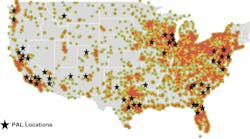Better sealing technology, innovative wheel-end packages mean less downtime.
Two of the biggest problems with trailer wheel-ends are improper wheel-seal installation and contamination of hub interiors when they're opened for service. And if there were some way to ensure that wheel bearings were properly adjusted, seals would have better odds of remaining intact. With seals in place, bearings would remain lubed and protected from corrosion and contamination damage.
However, seals do develop leaks, which, if undetected, result in damage. Improperly lubed bearings can overheat; in severe cases, they can run red hot and shear through a spindle, causing wheel loss. More commonly, however, failed seals lead to oil-soaked brakes and costly relines.
Since seal-installation instructions vary from one manufacturer to another, technicians often are tempted to forsake recommended tools and invent their own seal-seating systems, which may not work in every case.
Chicago Rawhide has developed an easy-to-fit seal that addresses the installation problem. The Scotseal is placed onto its own installation tool, centered, and tapped home. Techs know it has been fitted properly because it makes a "bottoming out" sound in the hub bore. This one-piece sealing element, made from a specially formulated nitrile rubber compound, resists heat and the chemical additives sometimes found in lube oil.
A number of new approaches to wheel-end sealing have been developed to sidestep potential problems in conventional designs. These approaches are particularly attractive to high-mileage fleets that track wheel-end costs. Eaton's LMS wheel-end package, for example, uses the ConMet aluminum hub and standard bearings. In addition, a special internal sleeve is used to set the bearing adjustment.
Meritor's TB "unitized" wheel-end comes as a sealed cartridge package -- hub, bearing, seal, and lube -- produced by SKF. The seal rides on the inner cone of the bearing, making no contact with the axle journal. The TB seal is referred to as an "includer" design because its function is not so much to keep dirt out as to keep the lube in. In the TB system, bearings are preadjusted to a 0.001-in. preload setting, which is said to provide longer seal and bearing life. Meritor Automotive is rumored to have a unitized wheel-end system for drive axles under development.
For conventional wheel-ends, Meritor has an agreement with Triseal to distribute the latter's oil-bath wheel seals for a variety of Class 6, 7, and 8 applications. They are sold under the "Maximum Value and Performance" brand. The MVP is a one-piece design that strives to eliminate seal-leak problems and lower maintenance costs by compensating for some degree of spindle imperfection and improper bearing adjustment. The MVP II, a two-piece wheel seal designed for extreme operating environments, features a specially treated leather sealing element with a dust exclusion wiper.
Stemco's Advantage 2000 is a package system that should be available in the near future. The hub, bearing, and spacer are clamped together, and a selective amount of material is ground from the spacer to get a highly accurate bearing setting. The sealing element runs on the spindle journal.
The Advantage 2000 has a patented oil distribution system, and a soon-to-be-released Discover seal. The innovative lip design defines this model as an exclusion seal because it keeps contaminants out. The lip is constantly relubricated to reduce wear and vent internal pressure, which helps increase fuel efficiency because less rolling resistance is exerted in the rotating hub. This can translate into savings of up to 10 gal./wheel-end over 100,000 mi.
Timken has developed the Wheel Boss system, an infinitely adjustable single-nut system that promises to offer fleets a highly precise method of bearing adjustment. A non-vented hub cap prevents contamination, and a patented seal is said to offer an advantage over oil-bath seals when used on grease lubricated wheel-ends. In the Timken system, however, both oil and grease can be used.
Triseal also has its own product line, which includes one- and two-piece oil-bath seals for steer, drive, and trailer axles. The company has developed a special installation tool that helps eliminate misalignment and damage during installation.
For conventional wheel-ends, the Outrunner seal, which is manufactured by Freudenberg-NOK exclusively for Eaton, blends a labyrinth sealing system with heat-resistant polyacrylate and other design features to provide long life and high performance.
Federal-Mogul's National 5-Star Gold Oil Bath Seal line uses a bi-directional sealing element made of Teflon. The cool-running seal provides a wide contact band that does a good job of absorbing wheel-end movement and minimizing the lube leakage problems associated with misaligned seals and bearing adjustment that is too loose. The Teflon lip has a temperature range of -60 to +450degF and is compatible with any lubricant package.


